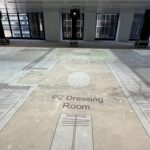Projection mapping is a technique that uses projectors to display images or videos on three-dimensional objects or spaces, creating various visual effects and illusions. It is a form of artistic expression and performance that can be used for entertainment, education, advertising, and more.
In this blog post, I will introduce you to the basics of projection mapping, how it works, and some examples of how it can be used.
How does projection mapping work?
Projection mapping works by projecting images or videos that are specially designed to match the shape and features of the object or space that is used as a screen. For example, if you want to project an image on a building, you need to create an image that fits the contours and windows of the building.
To create such images or videos, you need to use software that can map the object or space in 3D and adjust the perspective and distortion of the projection. You also need to consider the lighting conditions and the viewing angle of the audience.
Projection mapping requires multiple projectors to cover a large area or create a complex effect. The projectors need to be synchronized and calibrated to avoid overlapping or gaps in the projection. You also need a computer or a media server to control the projectors and play the images or videos.
What are some examples of projection mapping?
Projection mapping can be used for various purposes and occasions. Here are some examples of projection mapping projects that have been done around the world.
- Theme parks and amusement facilities: Projection mapping can enhance the attractions and shows at theme parks and amusement facilities by creating immersive and realistic environments. For example, Disney and Universal Studios have used projection mapping to project characters and scenes from their movies on their buildings and rides.
- World heritage sites and tourist spots: Projection mapping can showcase the beauty and history of world heritage sites and tourist spots by projecting images or videos that tell stories or convey messages. For example, Spain’s Sagrada Familia, UAE’s Sheikh Zayed Grand Mosque, and Australia’s Opera House have been illuminated by projection mapping shows.
- Corporate promotion: Projection mapping can be used for corporate promotion by projecting images or videos that advertise products or services on buildings or objects. For example, fashion brand RALPH LAUREN projected a fashion show on their shop’s wall to launch their perfume, and car maker Hyundai projected a video of a car driving on a wall with a real car hanging from it.
- Live performances and stages: Projection mapping can be used for live performances and stages by projecting images or videos that complement the music or the actors. For example, artists like Perfume and Hatsune Miku have used projection mapping to create dynamic and futuristic effects on their concerts, and 2.5D stages have used projection mapping to recreate the worlds of anime, manga, and games on stage.
How can you learn projection mapping?
If you are interested in learning projection mapping, there are some resources that can help you get started. Here are some suggestions:
- Online courses: There are online courses that teach you the basics of projection mapping, such as how to use software like MadMapper, how to set up projectors, how to create images or videos, etc. You can find some courses on platforms like Udemy or Skillshare.
- Books: There are books that explain the theory and practice of projection mapping, such as how to design images or videos, how to choose projectors, how to plan projects, etc. You can find some books on Amazon or other online bookstores.
- Workshops: There are workshops that offer hands-on experience of projection mapping, such as how to use equipment, how to create images or videos, how to project on objects or spaces, etc. You can find some workshops on websites like Eventbrite or Meetup.
- Projects: There are projects that invite you to participate in projection mapping events or festivals, such as creating images or videos for a specific theme or location, collaborating with other artists or organizations, etc. You can find some projects on websites like Kickstarter or Indiegogo.
Projection mapping is a fascinating and creative technique that can transform any object or space into a screen for your imagination. If you want to learn more about projection mapping, I hope this blog post has given you






